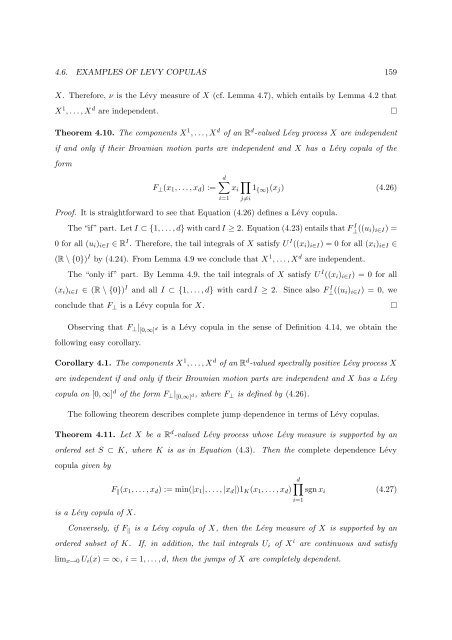Processus de Lévy en Finance - Laboratoire de Probabilités et ...
Processus de Lévy en Finance - Laboratoire de Probabilités et ...
Processus de Lévy en Finance - Laboratoire de Probabilités et ...
Create successful ePaper yourself
Turn your PDF publications into a flip-book with our unique Google optimized e-Paper software.
4.6. EXAMPLES OF LEVY COPULAS 159<br />
X. Therefore, ν is the Lévy measure of X (cf. Lemma 4.7), which <strong>en</strong>tails by Lemma 4.2 that<br />
X 1 , . . . , X d are in<strong>de</strong>p<strong>en</strong><strong>de</strong>nt.<br />
Theorem 4.10. The compon<strong>en</strong>ts X 1 , . . . , X d of an R d -valued Lévy process X are in<strong>de</strong>p<strong>en</strong><strong>de</strong>nt<br />
if and only if their Brownian motion parts are in<strong>de</strong>p<strong>en</strong><strong>de</strong>nt and X has a Lévy copula of the<br />
form<br />
F ⊥ (x 1 , . . . , x d ) :=<br />
d∑ ∏<br />
x i 1 {∞} (x j ) (4.26)<br />
i=1 j≠i<br />
Proof. It is straightforward to see that Equation (4.26) <strong>de</strong>fines a Lévy copula.<br />
The “if” part. L<strong>et</strong> I ⊂ {1, . . . , d} with card I ≥ 2. Equation (4.23) <strong>en</strong>tails that F⊥ I ((u i) i∈I ) =<br />
0 for all (u i ) i∈I ∈ R I . Therefore, the tail integrals of X satisfy U I ((x i ) i∈I ) = 0 for all (x i ) i∈I ∈<br />
(R \ {0}) I by (4.24). From Lemma 4.9 we conclu<strong>de</strong> that X 1 , . . . , X d are in<strong>de</strong>p<strong>en</strong><strong>de</strong>nt.<br />
The “only if” part. By Lemma 4.9, the tail integrals of X satisfy U I ((x i ) i∈I ) = 0 for all<br />
(x i ) i∈I ∈ (R \ {0}) I and all I ⊂ {1, . . . , d} with card I ≥ 2. Since also F⊥ I ((u i) i∈I ) = 0, we<br />
conclu<strong>de</strong> that F ⊥ is a Lévy copula for X.<br />
Observing that F ⊥ | [0,∞] d<br />
following easy corollary.<br />
is a Lévy copula in the s<strong>en</strong>se of Definition 4.14, we obtain the<br />
Corollary 4.1. The compon<strong>en</strong>ts X 1 , . . . , X d of an R d -valued spectrally positive Lévy process X<br />
are in<strong>de</strong>p<strong>en</strong><strong>de</strong>nt if and only if their Brownian motion parts are in<strong>de</strong>p<strong>en</strong><strong>de</strong>nt and X has a Lévy<br />
copula on [0, ∞] d of the form F ⊥ | [0,∞] d, where F ⊥ is <strong>de</strong>fined by (4.26).<br />
The following theorem <strong>de</strong>scribes compl<strong>et</strong>e jump <strong>de</strong>p<strong>en</strong><strong>de</strong>nce in terms of Lévy copulas.<br />
Theorem 4.11. L<strong>et</strong> X be a R d -valued Lévy process whose Lévy measure is supported by an<br />
or<strong>de</strong>red s<strong>et</strong> S ⊂ K, where K is as in Equation (4.3). Th<strong>en</strong> the compl<strong>et</strong>e <strong>de</strong>p<strong>en</strong><strong>de</strong>nce Lévy<br />
copula giv<strong>en</strong> by<br />
d∏<br />
F ‖ (x 1 , . . . , x d ) := min(|x 1 |, . . . , |x d |)1 K (x 1 , . . . , x d ) sgn x i (4.27)<br />
is a Lévy copula of X.<br />
Conversely, if F ‖ is a Lévy copula of X, th<strong>en</strong> the Lévy measure of X is supported by an<br />
or<strong>de</strong>red subs<strong>et</strong> of K. If, in addition, the tail integrals U i of X i are continuous and satisfy<br />
lim x→0 U i (x) = ∞, i = 1, . . . , d, th<strong>en</strong> the jumps of X are compl<strong>et</strong>ely <strong>de</strong>p<strong>en</strong><strong>de</strong>nt.<br />
i=1
















